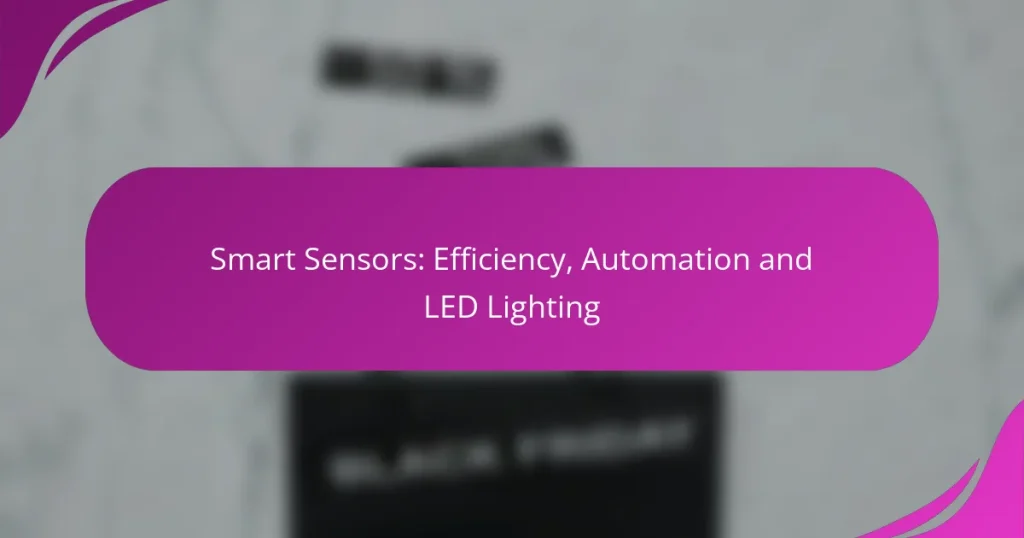Smart sensors play a crucial role in enhancing the efficiency of LED lighting by automating control and optimizing energy usage based on real-time conditions. By providing precise adjustments, these sensors reduce waste and improve overall performance, making them essential for modern lighting solutions.
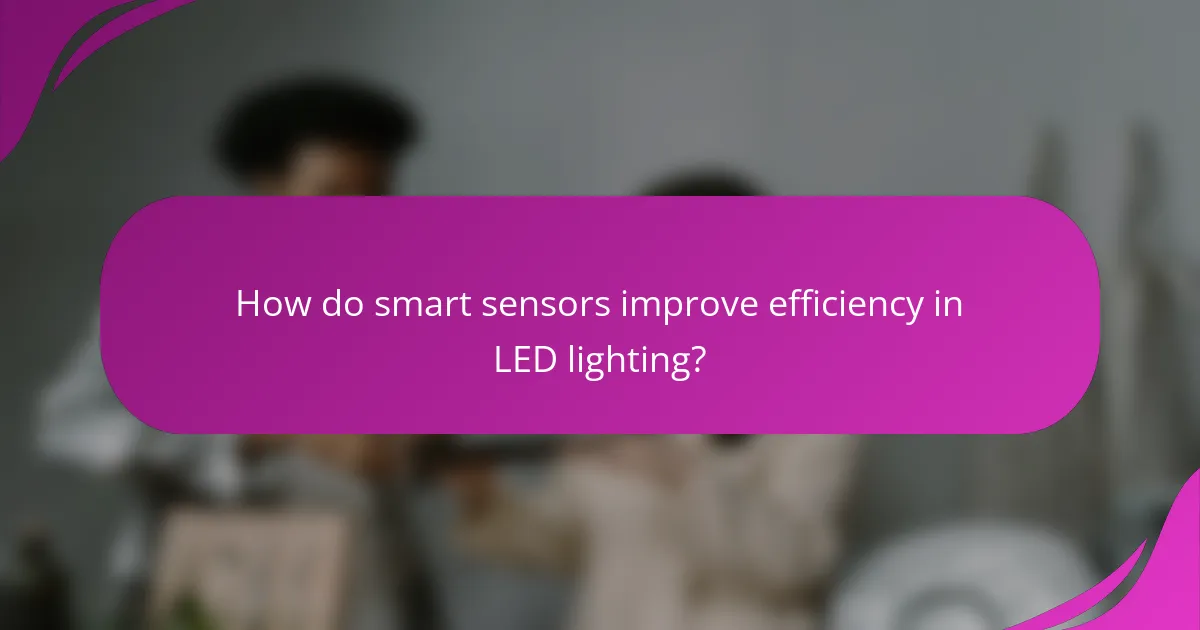
How do smart sensors improve efficiency in LED lighting?
Smart sensors enhance efficiency in LED lighting by automating control and optimizing energy usage based on real-time conditions. This technology allows for precise adjustments that reduce waste and improve overall performance.
Energy savings through automation
Smart sensors enable automated lighting systems that adjust brightness based on occupancy and ambient light levels. For example, lights can dim or turn off in unoccupied spaces, leading to energy savings of up to 30-50% in commercial settings.
Implementing motion sensors and daylight harvesting can significantly lower electricity bills, making it a cost-effective solution for both residential and commercial properties. Regular maintenance and updates to the system can further enhance these savings.
Real-time monitoring and adjustments
Real-time monitoring allows smart sensors to continuously assess environmental conditions and make immediate adjustments to lighting. This responsiveness ensures optimal lighting levels, which can improve comfort and productivity in workplaces.
For instance, sensors can detect changes in natural light and adjust LED brightness accordingly, maintaining consistent illumination while minimizing energy consumption. This capability is particularly beneficial in dynamic environments like offices or retail spaces.
Integration with smart home systems
Smart sensors can seamlessly integrate with existing smart home systems, allowing users to control LED lighting through mobile apps or voice commands. This integration enhances user convenience and promotes energy-efficient habits.
Homeowners can set schedules or create scenes that automatically adjust lighting based on their routines, further optimizing energy use. Additionally, compatibility with platforms like Google Home or Amazon Alexa can simplify management and enhance overall efficiency.

What are the benefits of using smart sensors for automation?
Smart sensors enhance automation by providing real-time data and control, leading to improved efficiency and responsiveness. They enable systems to adapt to changing conditions, optimize resource usage, and streamline operations across various applications.
Enhanced user control
Smart sensors significantly improve user control by allowing for personalized settings and adjustments based on real-time feedback. For example, in smart lighting systems, users can adjust brightness and color temperature through mobile apps or voice commands, creating an environment that suits their preferences.
These sensors can also learn user habits over time, automatically adjusting settings to enhance comfort and convenience. This level of control can lead to a more satisfying user experience and increased engagement with the technology.
Reduced operational costs
Implementing smart sensors can lead to substantial reductions in operational costs by optimizing energy consumption and minimizing waste. For instance, smart lighting systems can automatically turn off lights in unoccupied areas, potentially reducing energy bills by a significant percentage.
Additionally, predictive maintenance enabled by smart sensors can prevent costly equipment failures. By monitoring performance and detecting anomalies early, businesses can schedule maintenance only when necessary, avoiding unnecessary downtime and repair expenses.
Increased safety and security
Smart sensors enhance safety and security by providing continuous monitoring and immediate alerts for unusual activities. For example, motion sensors can detect unauthorized access and trigger alarms or notifications to the property owner or security personnel.
In industrial settings, smart sensors can monitor environmental conditions, such as gas leaks or temperature fluctuations, ensuring a safe working environment. Compliance with safety regulations is easier to maintain, as these systems can provide real-time data and reports for audits and inspections.
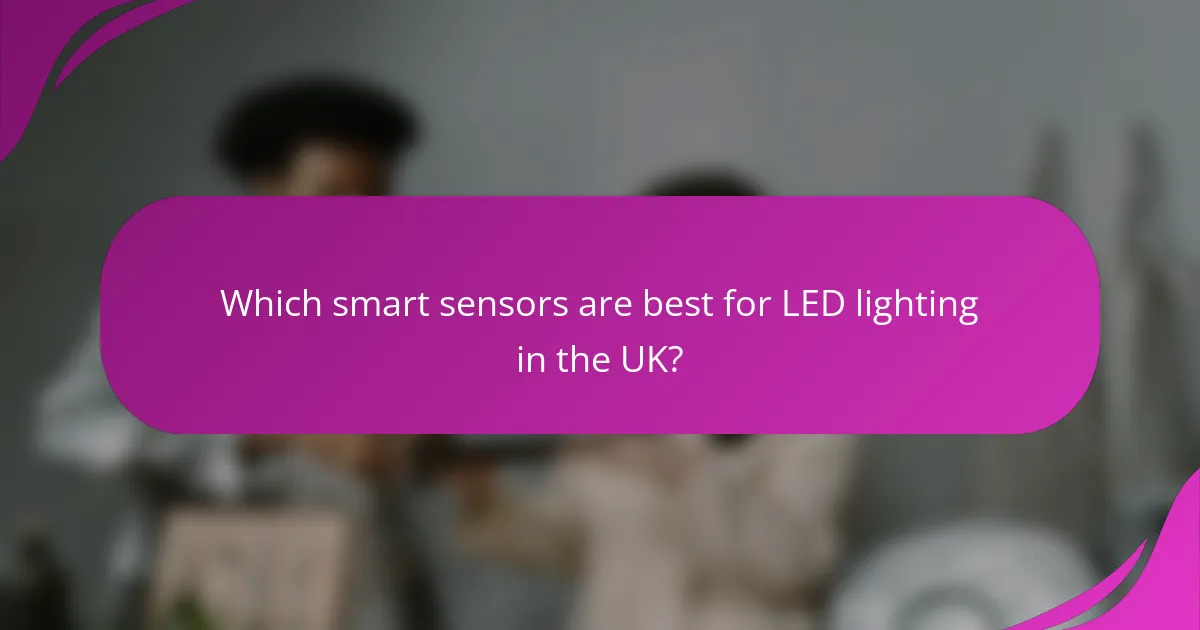
Which smart sensors are best for LED lighting in the UK?
The best smart sensors for LED lighting in the UK are those that enhance energy efficiency and automate lighting control. Key options include Philips Hue sensors, Ecobee SmartSensor, and Honeywell Home sensors, each offering unique features tailored for various needs.
Philips Hue sensors
Philips Hue sensors are designed to work seamlessly with the Philips Hue lighting system, providing motion detection and ambient light sensing. These sensors can automatically adjust lighting based on occupancy and natural light levels, ensuring optimal energy use.
Installation is straightforward, typically requiring no professional help. They connect via Zigbee, making them compatible with other smart home devices. Users should consider the sensor’s range, which is generally effective within a few meters.
Ecobee SmartSensor
Ecobee SmartSensors are versatile devices that can monitor both temperature and occupancy, making them ideal for controlling LED lighting in conjunction with heating and cooling systems. This dual functionality allows for more comprehensive home automation.
These sensors can be placed in various rooms to ensure even lighting and climate control. They communicate over Wi-Fi, which may require a stable internet connection for optimal performance. Users should be aware of battery life, which typically lasts several months before needing replacement.
Honeywell Home sensors
Honeywell Home sensors offer reliable motion detection and can be integrated into existing smart home ecosystems. They are particularly useful for security and energy management, allowing lights to turn on or off based on movement.
These sensors are easy to install and often come with a mobile app for remote management. Users should check compatibility with their current smart home devices, as some models may require specific hubs. Regular maintenance, such as checking battery levels, is recommended to ensure consistent operation.
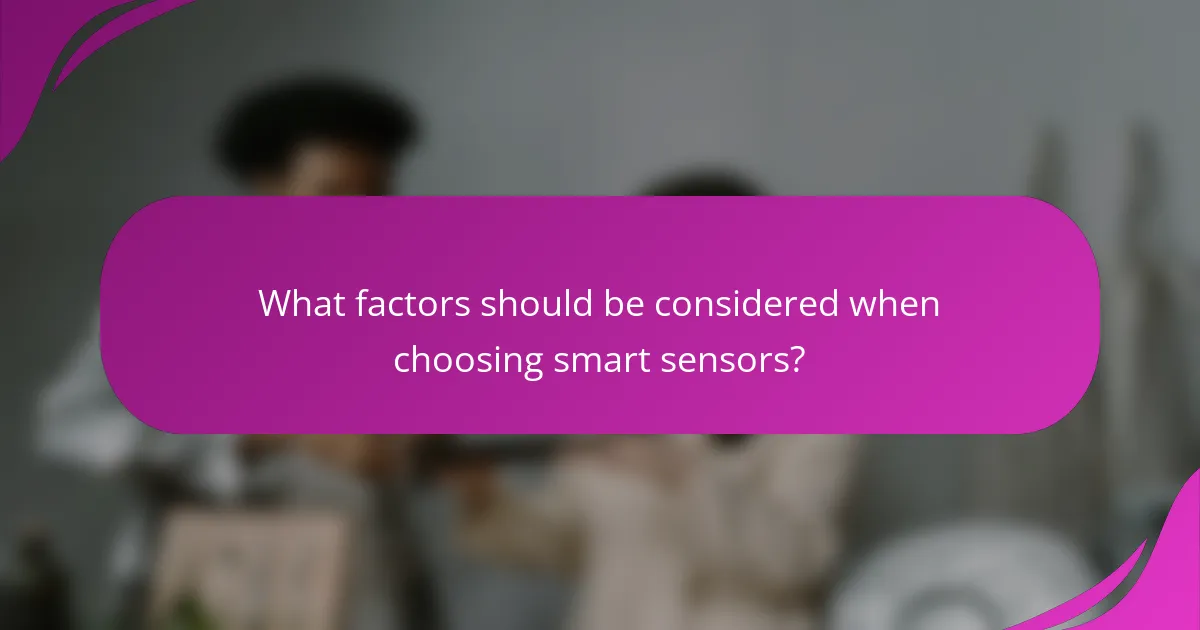
What factors should be considered when choosing smart sensors?
When selecting smart sensors, consider compatibility with existing systems, sensor range and accuracy, and cost along with installation requirements. These factors will significantly influence the effectiveness and efficiency of your smart sensor deployment.
Compatibility with existing systems
Ensure that the smart sensors you choose can seamlessly integrate with your current infrastructure. Compatibility with existing systems can prevent costly upgrades and ensure smooth operation. Check for standard communication protocols like Zigbee, Z-Wave, or Wi-Fi that your current devices support.
For example, if your building management system uses BACnet, opt for sensors that are compatible with this protocol to facilitate easy integration and data sharing.
Sensor range and accuracy
The range and accuracy of smart sensors are critical for their performance. Consider the area that needs monitoring and the specific application to determine the required range. For instance, indoor sensors typically have a range of a few meters, while outdoor sensors may need to cover larger distances.
Accuracy is equally important; look for sensors that provide reliable readings within acceptable tolerances. For example, temperature sensors should ideally have an accuracy of ±0.5°C to ensure effective climate control.
Cost and installation requirements
Evaluate the total cost of ownership, which includes the purchase price, installation, and maintenance expenses. Some smart sensors may have a lower initial cost but could incur higher operational costs due to frequent battery replacements or maintenance needs.
Installation requirements can vary significantly. Some sensors may be plug-and-play, while others might require professional installation. Always factor in these costs and the time needed for setup when making your decision.
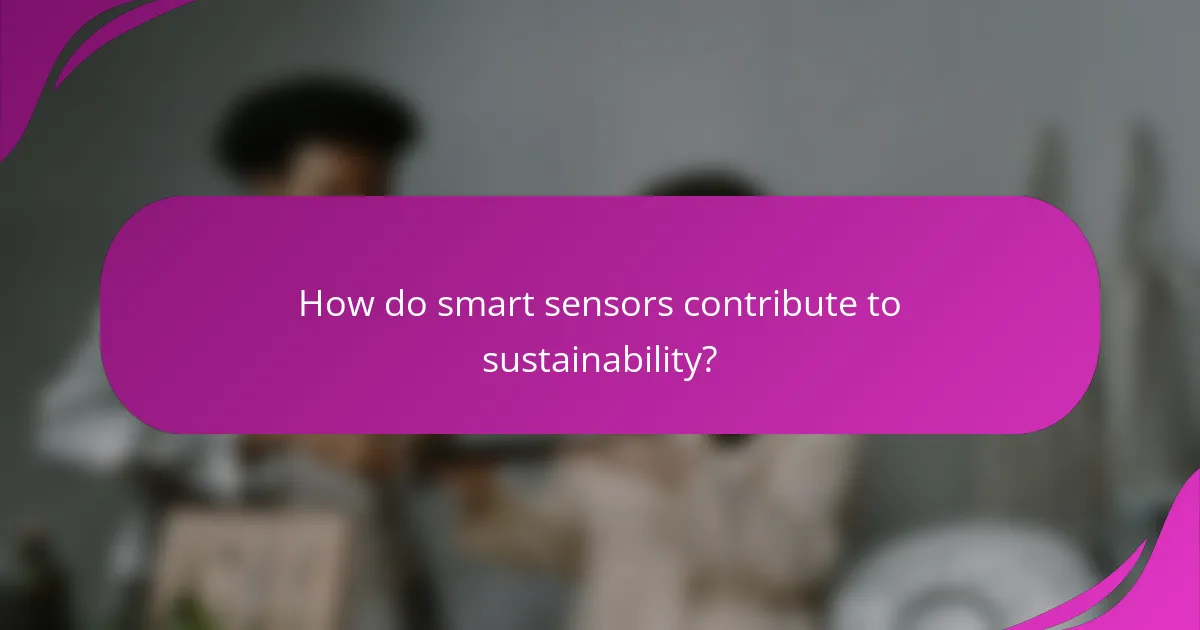
How do smart sensors contribute to sustainability?
Smart sensors enhance sustainability by optimizing energy use and reducing waste in various applications. These devices monitor environmental conditions and adjust systems accordingly, leading to more efficient resource management.
Reduction of carbon footprint
Smart sensors play a critical role in reducing the carbon footprint of buildings and industrial processes. By automatically adjusting lighting, heating, and cooling based on occupancy and environmental conditions, they can significantly lower energy consumption.
For instance, smart lighting systems equipped with occupancy sensors can reduce energy use by up to 30% in commercial spaces. This not only decreases greenhouse gas emissions but also lowers utility costs, making it economically beneficial.
Support for renewable energy sources
Smart sensors facilitate the integration of renewable energy sources like solar and wind into existing energy grids. They provide real-time data on energy production and consumption, allowing for better management of these variable energy sources.
For example, smart sensors can optimize the use of solar panels by adjusting energy storage and distribution based on weather conditions and energy demand, enhancing overall efficiency. This capability supports a transition to cleaner energy systems and reduces reliance on fossil fuels.

What are the future trends in smart sensors for LED lighting?
Future trends in smart sensors for LED lighting focus on enhanced automation, energy efficiency, and integration with IoT technologies. These advancements aim to optimize lighting systems for better performance, user comfort, and sustainability.
Increased Integration with IoT
Smart sensors are increasingly being integrated with Internet of Things (IoT) platforms, allowing for real-time data exchange and remote management. This connectivity enables users to monitor and control lighting systems from anywhere, enhancing convenience and energy savings.
For example, smart LED lights can adjust their brightness based on occupancy or ambient light levels, significantly reducing energy consumption. This integration also supports predictive maintenance, where sensors can alert users to potential issues before they become critical.
Enhanced Energy Efficiency
Future smart sensors will prioritize energy efficiency, utilizing advanced algorithms to optimize power usage. By analyzing usage patterns, these sensors can adjust lighting based on actual needs, which can lead to energy savings of up to 30-50% in commercial settings.
Moreover, the adoption of energy-efficient LED technology combined with smart sensors will help meet regulatory standards and sustainability goals. Businesses can benefit from lower utility bills and potential rebates for energy-efficient upgrades.
Improved User Experience
Smart sensors are designed to enhance user experience through personalization and automation. Features like adaptive lighting, which changes based on the time of day or user preferences, create a more comfortable environment.
Additionally, voice-activated controls and mobile app interfaces allow users to easily adjust settings, providing flexibility and convenience. This focus on user-centric design is expected to drive greater adoption of smart lighting solutions.
Data-Driven Insights
As smart sensors collect data on lighting usage and patterns, they provide valuable insights for businesses and homeowners. Analyzing this data can help identify trends, optimize energy consumption, and improve overall lighting strategies.
For instance, businesses can use data analytics to determine peak usage times and adjust their lighting schedules accordingly, further enhancing energy efficiency and reducing costs. This data-driven approach is becoming essential for informed decision-making in lighting management.
